A few of my favorite things: Cristina Diaz-Carrera
Smithsonian staff work countless hours in the halls of our museums and research centers, in the field, at the Zoo, in our gardens and facilities. We are privileged to spend time with some of the nation’s most cherished treasures as we go about our duties. Sometimes, these unique experiences find a special place in our own personal stories. Amy Kehs introduces Cristina Diaz-Carrerra and a few of her favorite things.
Cristina Diaz-Carrera is a curator at the Center for Folklife and Cultural Heritage, where she began as an intern in 2004. Each year, she and her co-workers achieve the monumental task of bringing participants from all over the world to what has become a Washington, D.C., summer tradition, the Smithsonian Folklife Festival. The Festival participants gather on the National Mall—a symbolic gesture in and of itself—for 10 days to share their art, craft, music, culture and heritage. This summer, Cristina will be the co-curator for the 2018 Festival program on Catalonia. This will be Cristina’s 14th Festival.
One of Cristina’s favorite Smithsonian objects is the Q’eswachaka Bridge from the 2015 Smithsonian Folklife Festival. Creating a replica of the rope bridge, a smaller version of one built each year in the town of Q’eswachaka, Peru, required a lot of bridge building itself. “The Smithsonian Folklife Festival is almost always about building bridges but, there was nothing more concrete than building an actual bridge on the National Mall for the 2015 Peru Folklife Festival program,” She explains. In addition to the real bridge, many symbolic bridges were built that summer. The research she conducted with the bridge-building communities itself was a collaboration with colleagues at the National Museum of the American Indian, with the goal to not only bring the bridge to the Mall for the Festival but also display it afterwards at NMAI.
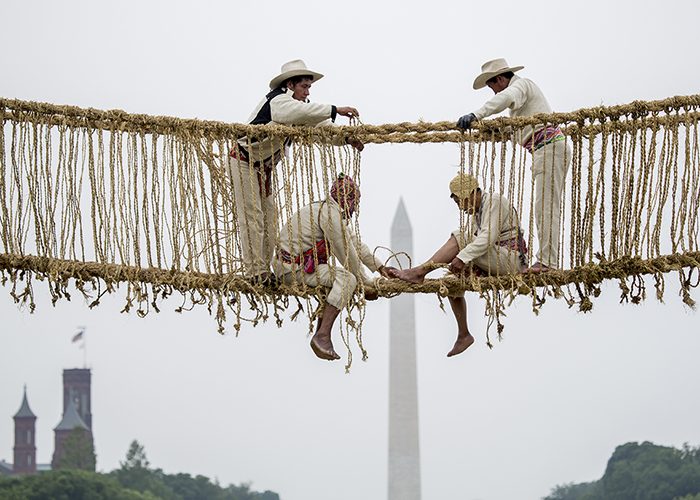
The engineers from Quehue complete the Q’eswachaka Bridge at the 2015 Folklife Festival.
Photo by Francisco Guerra, Ralph Rinzler Folklife Archives
Bridges were also built between government entities. The Q’eswachaka Bridge is built each year from grass that is harvested from a particular place and at a particular time of year. In order for the grass to arrive in Washington in time for the Festival, the harvest had to done early and partial ropes made and sent to the Mall for completion. “There was a lot of hard work that needed to take place in order for the materials to be harvested, partially woven in Peru and then shipped in time to the United States,” Christina says. “It was a huge group effort and involved many groups’ cooperation to ensure its success.”
It takes about a hundred people to build the bridge every year in Q’eswachaka, but since there weren’t that many Q’eswachakans on hand, the bridge builders created a new community of Smithsonian staff and other Peruvian participants at the Festival.
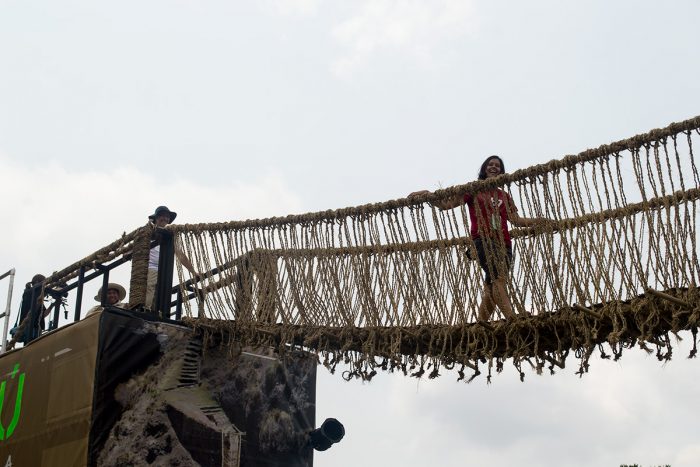
Cristina Diaz-Carrera crosses the bridge made for the 2015 Smithsonian Folklife Festival’s Peru program. Photo by Sarah Bluestein, Ralph Rinzler Folklife Archives
“The many collaborations that took place made this symbol of the program even more special. At the end of the Festival, each group had a chance to walk across the bridge, completing their journey and their Festival experience, “ Cristina says. A portion of the bridge is now on view in the Inca Road exhibit at NMAI on the Mall and another section is on exhibit at NMAI’s George Gustav Heye Center in New York.
The Smithsonian Folkways Recording label is the nonprofit record label of the Smithsonian. It was founded in 1948 by Moses Asch and later acquired by the Smithsonian. Its mission is to document music, spoken word, instruction and sounds from around the world. Cristina’s second favorite thing is the Smithsonian Folkways recording “¡Así Kotama!,” part of Folkways’ Tradiciones/Traditions initiative, which seeks to document and promote Latino grassroots music. Cristina joined the Smithsonian team, led by then-Smithsonian Folkways Director Dan Sheehy, for a trip to Imbabura, Ecuador, where they worked with members of the Hatun Kotama Escuela de Flauta (Hatun Kotama Flute School) to record flute traditions in that part of the world. The school has sparked interest in the community by preserving and teaching traditional flute to young people, who are also finding rekindled interest in their native language. The recording by Folkways captures the results of that effort and features flutists ages 8 to 72.
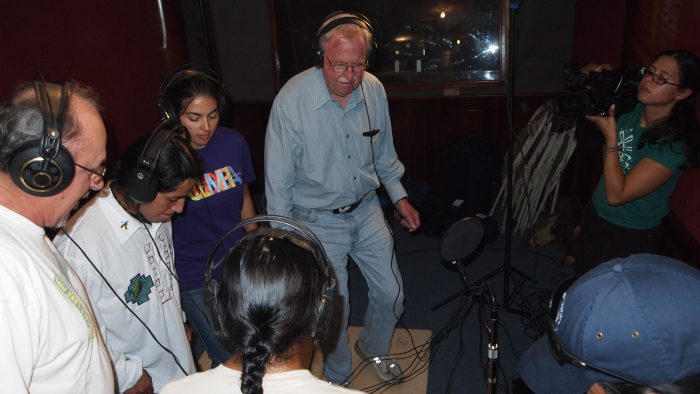
Cristina Diaz-Carrera (far right) documents members of the flute group Hatun Kotama alongside staff from the Smithsonian Center for Folklife and Cultural Heritage during the recording of the bonus track for the “Asi Kotama” Folkways record.
Photo credit: Patricio Maldonado Quinchuquí
At the end of the recording session, the Smithsonian team was able to lend a hand with a special bonus track, “Yaku Chaka” (Puente del rio “River Bridge”). For the bonus track, the artists invited Smithsonian staff to learn the song and help them play it for the studio recording. For Cristina, it was a very special full-circle moment. Cristina’s family is from that part of Ecuador. In fact, she had visited Otavalo, the large city in the region, many times on vacation with her family as a child. “Having the chance to participate in this recording with a culture that was so near and dear to my heart was special and very moving,” she said.
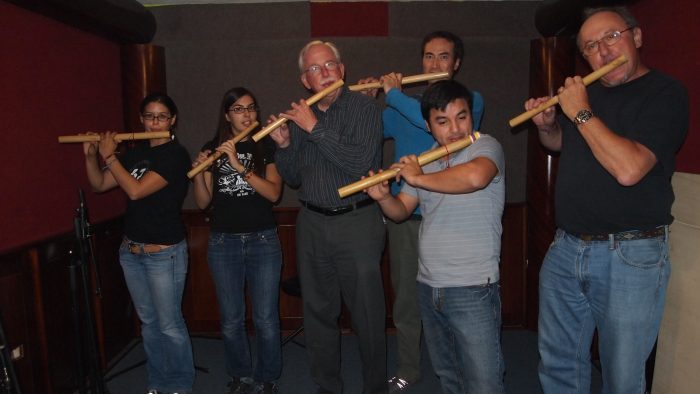
Diaz-Carrera (far left) plays traditional flute music with her colleagues during the recording of “Asi Kotama.” Cristina Diaz-Carrera, Jessie Vallejo, Dan Sheehy, Charlie Weber, Santiago Chicaiza, Pete Reiniger
Photo credit: Patricio Maldonado Quinchuquí
Cristina’s third Smithsonian favorite are the bamboo tent structures from the “Colombia: The Nature of Culture” program at the 2011 Folklife Festival. Using a combination of native and modern building techniques, Festival participants and staff showed visitors the strong connection between the Colombians’ culture and their environment. The unique architecture, which featured guadua, a strong bamboo building material, was designed and implemented by Simón Hosie Samper and Ivonne Valencia. It was one of the most extensive building projects that a Festival program has ever taken on. The Colombia program is also a great example of what the Smithsonian Folklife Festival staff strives to achieve after the tents are dismantled and the summer tourists depart. Cristina and her co-workers hope that the momentum and experiences of the Festival inspire the participants to take those connections and knowledge back to their homes, empowered in their efforts to sustain their culture and heritage. The Colombia program has been “restaged” several times since its initial showing at the 2011 Folklife Festival. The connections made have given new life to the program, reinforcing connections between the traditional artists involved, and continuing to educate local Colombian audiences about their diverse cultural heritage.
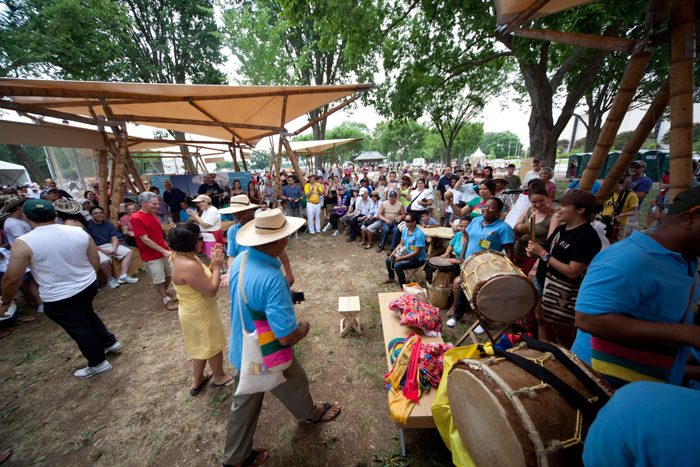
Visitors and artists interact under the guadua (bamboo) tents in the Colombia program area during the 2011 Folklife Festival. Photo by Francisco Guerra/Smithsonian Institution
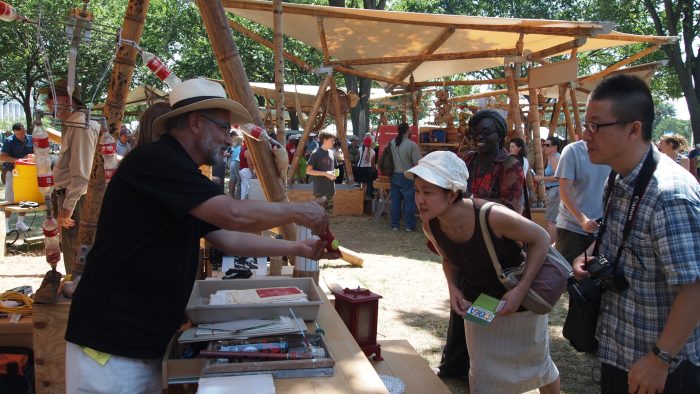
Artisan Hernando Ruíz, who specializes in creating new arts forms from recycled materials, talks to visitors during the Colombia Folklife Festival program. Photo by Cristina Diaz-Carrera
Cristina’s favorite things summarize very eloquently everything she loves about her work at the Smithsonian. As with the Peruvian bridge, she loves that the work she does builds bridges from the past to present, from country to country; and from person to person. It is these connections that make Cristina so proud of the work that the Smithsonian Folklife Festival does each year.
Posted: 26 February 2018
- Categories:
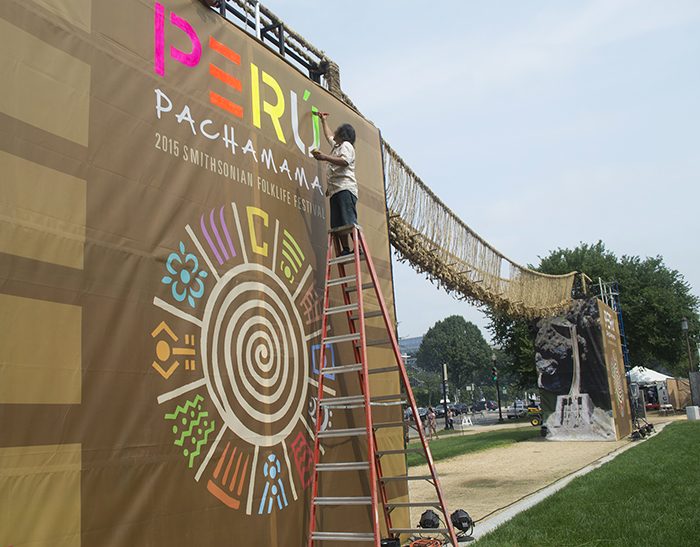




Dear Ms. Amy Kehs, I liked your interviewed my good friend Charles Nobles , he is cool person that used to work with him and his colleague at Exhibit Division on Asian Arts and Crafts Day ( one day event) during in month of May for many years at the Elephants Hall since 1984 till ended in 2011.
THANKS to share
Regards
Vichai Malikul., Scientific Illustrator, NMNH